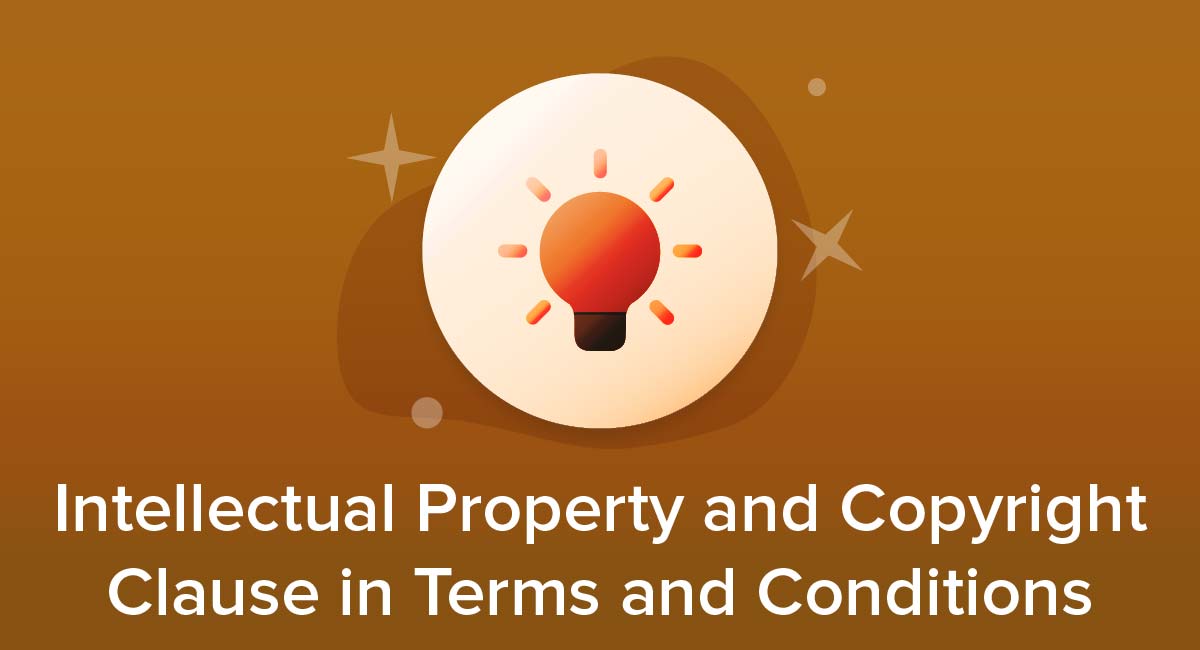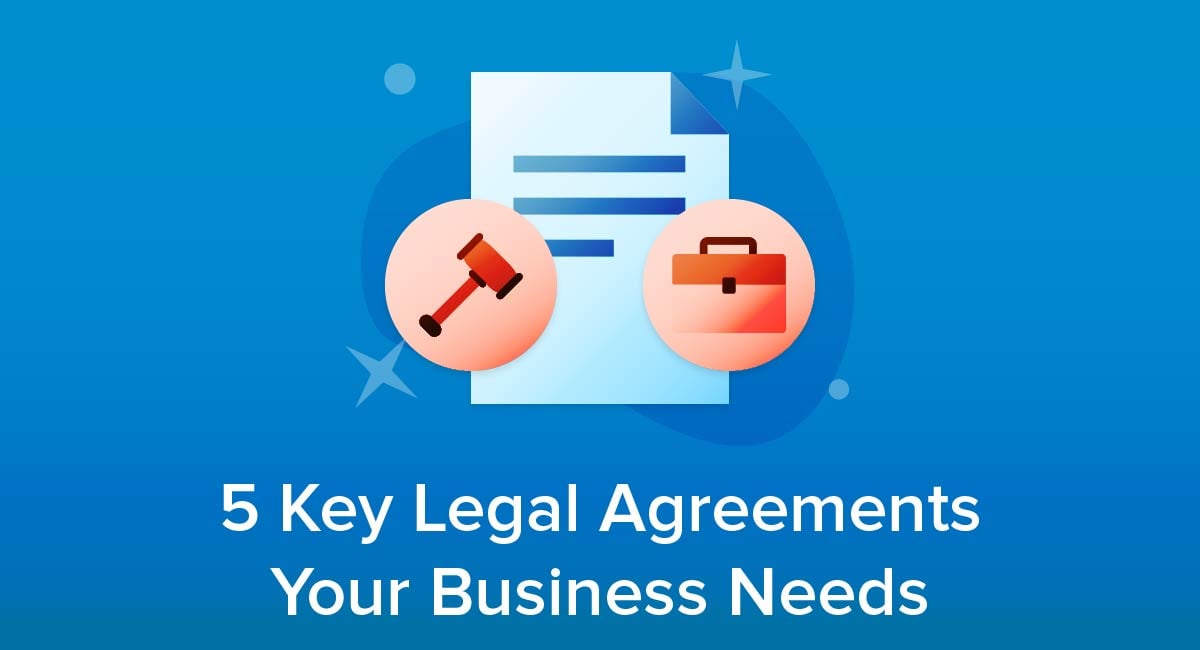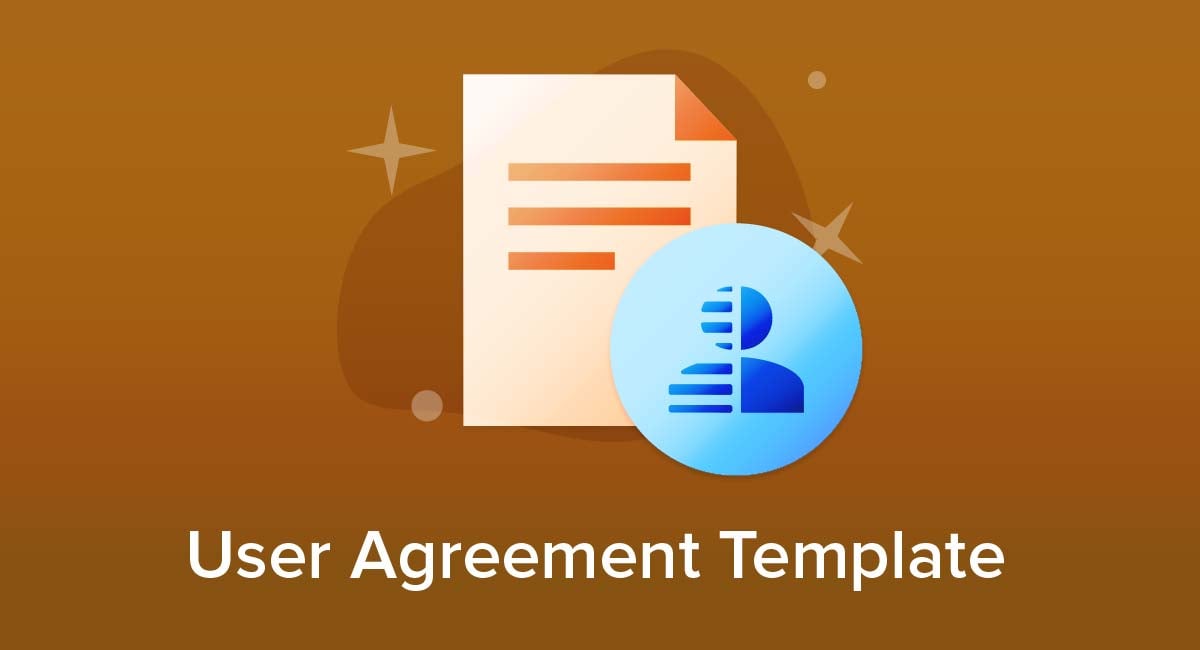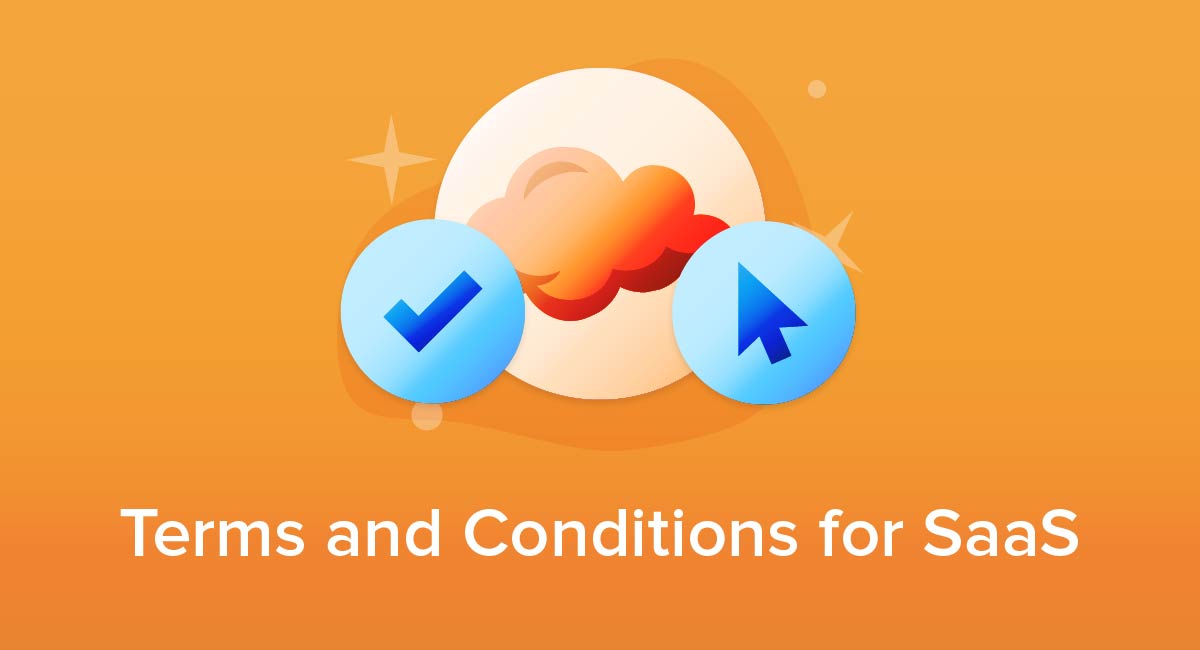
What is a Terms and Conditions Agreement and is having one important to SaaS companies?
A Terms and Conditions Agreement (T&C) is one of the most important legal documents for companies to include on their web pages and apps. SaaS, or Software as a Service, companies provide software through licensing and delivery to companies and customers. Because of this, they need special protections that a T&C can offer.
To protect your company from potential legal issues and possible risks from providing software and services to your users, including an agreement that relays your rules and regulations to your customers is a must. That's where a Terms and Conditions agreement comes in.
Our Free Terms and Conditions Generator is created to help you generate a professionally drafted agreement that can include various terms and conditions for your site and/or app.
- Start the Free Terms and Conditions Generator from our website.
- Select platforms where your Terms and Conditions will be used (website, app or both):
- Answer a few questions about your website or app information:
- Select the country:
- Answer a few questions about your business practices:
-
Enter your email address where you'd like to receive the new Free Terms and Conditions and click "Generate":
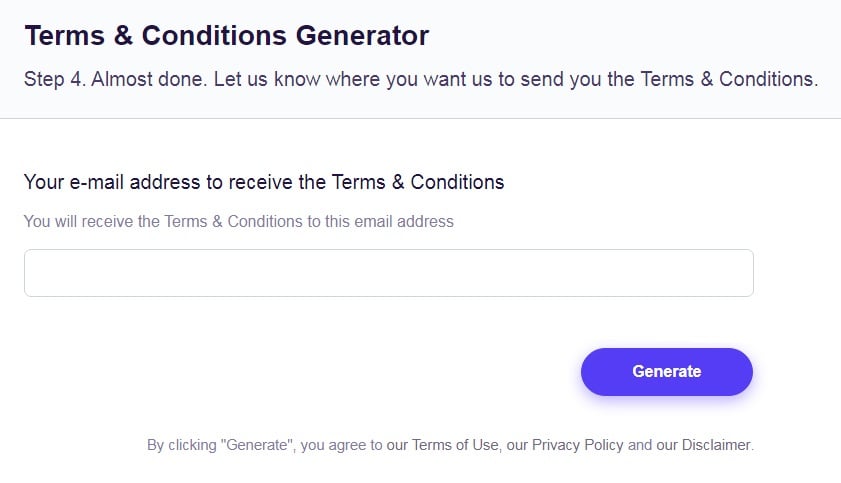
Once generated, you can copy and paste your Free Terms and Conditions agreement on your website or app or link to your hosted Free Terms and Conditions page.
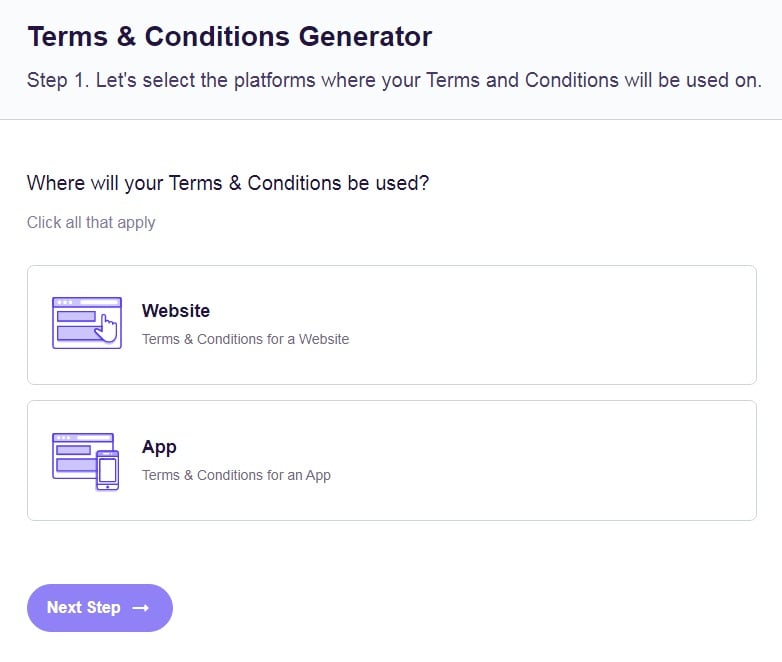
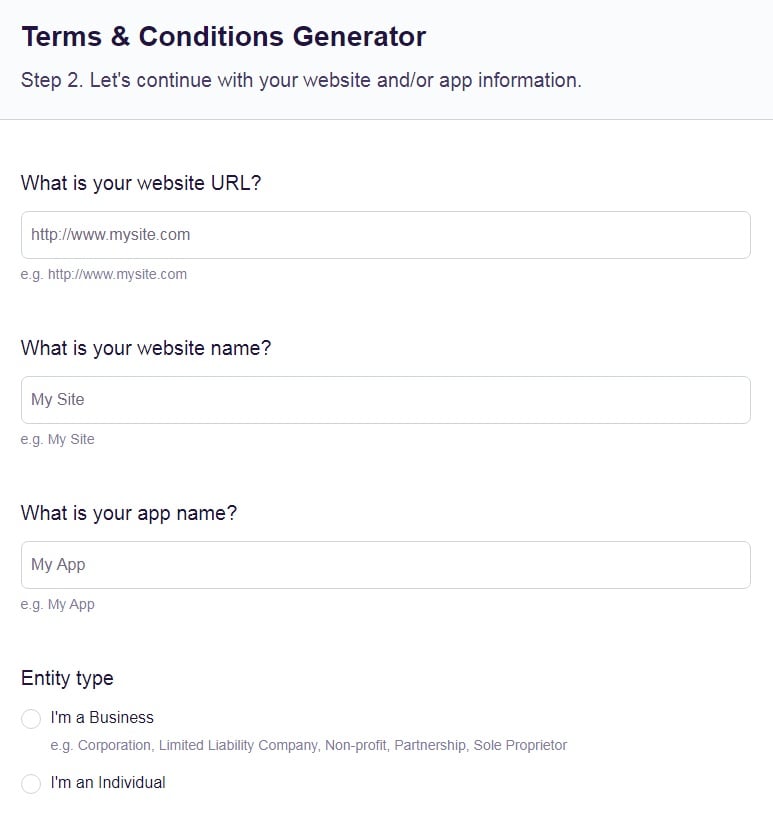
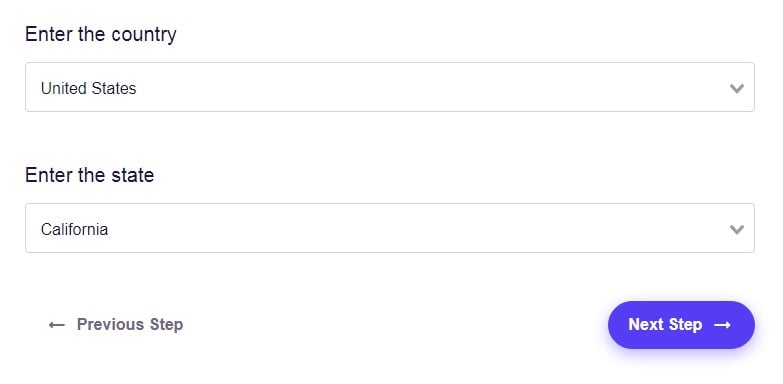
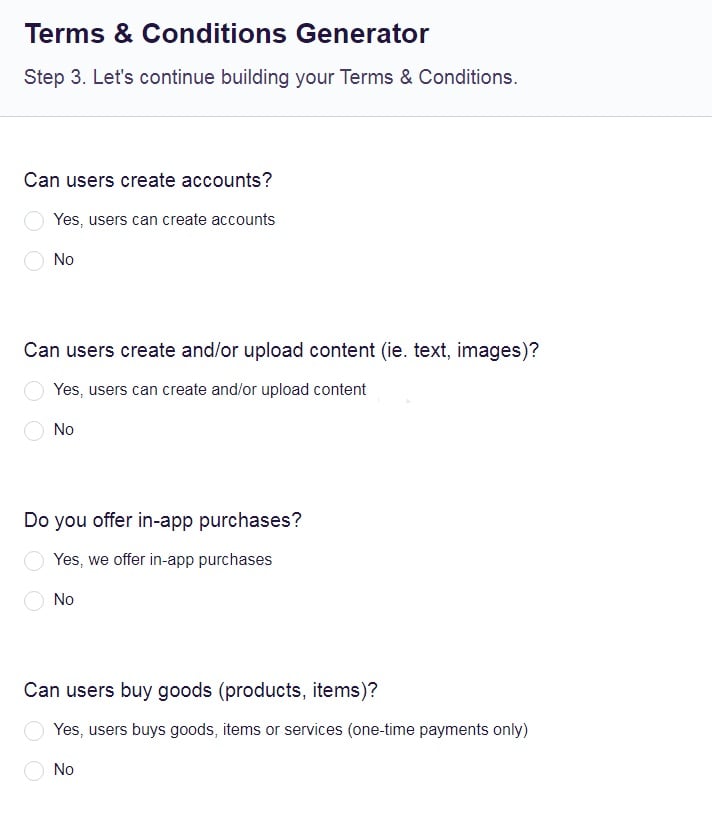
- 1. What is a Terms and Conditions Agreement?
- 2. Why is a Terms and Conditions Agreement Important for SaaS?
- 3. What Clauses to Include in Your Terms and Conditions
- 3.1. Legally Binding Statement
- 3.2. Eligibility of Usage of Services
- 3.3. Licensing Information and Limitation
- 3.4. Termination of Usage
- 3.5. Intellectual Property
- 3.6. User-Generated Content
- 3.7. Payment of Services and Usage
- 3.8. Limitation of Liability
- 3.9. Governing Law
- 3.10. Modification or Updates to the Terms
- 3.11. Contact Information and How to Contact
- 4. How to Display and Get Agreement to Your Terms and Conditions
- 4.1. Getting Agreement
- 5. Summary
What is a Terms and Conditions Agreement?
A Terms and Conditions Agreements is an agreement between your company and your users. Once agreed to by your users, a legally binding contract is created.
These terms lay out the rules, regulations, and expectations that a user must follow to use a company's services or systems. Violations of these rules can mean the ending of the usage, probation, and on some occasions, legal issues.
While a Terms and Conditions isn't legally required, it is highly recommended for your company to include one. Terms and Conditions, also called Terms of Use or Terms of Service, provide protection to your company if any foreseeable legal issues.
Why is a Terms and Conditions Agreement Important for SaaS?

As mentioned above, a Terms and Conditions Agreement isn't required by law, but is extremely beneficial to have. So why then would your company or app need one?
First, Terms and Conditions agreements allow you to control how your customers use and interact with your services.
SaaS companies deliver a wide variety of services to both companies and consumers. As these services and software programs are associated with the SaaS, having control of the usage is essential. With anyone being able to use your software, laying out your rules clearly is very important.
Mailchimp includes some simple, but clear statements of the type of use they don't allow when using their services in its Standard Terms of Use:
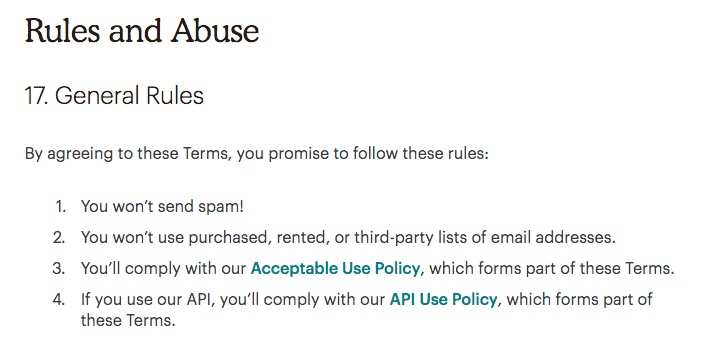
Second, a Terms and Conditions allows you to cancel a subscription or use of your service when a customer violates the rules.
In a Terms and Conditions, you can dictate how your services are used and how usage may be terminated. As customers can use your software for many reasons and on many different applications, stating your reasons for canceling or suspending services may be extremely important in the long run.
A Terms and Conditions allows you to protect your business from and plan for any future issues if someone decides to file a lawsuit against your company.
Take a look at the marketing and sales SaaS company HubSpot's Terms of Service. Its section on "Use and Limitations of Use" lays out clear restrictions on how the software can be accessed and used, including attempting to access the services through unapproved platforms:
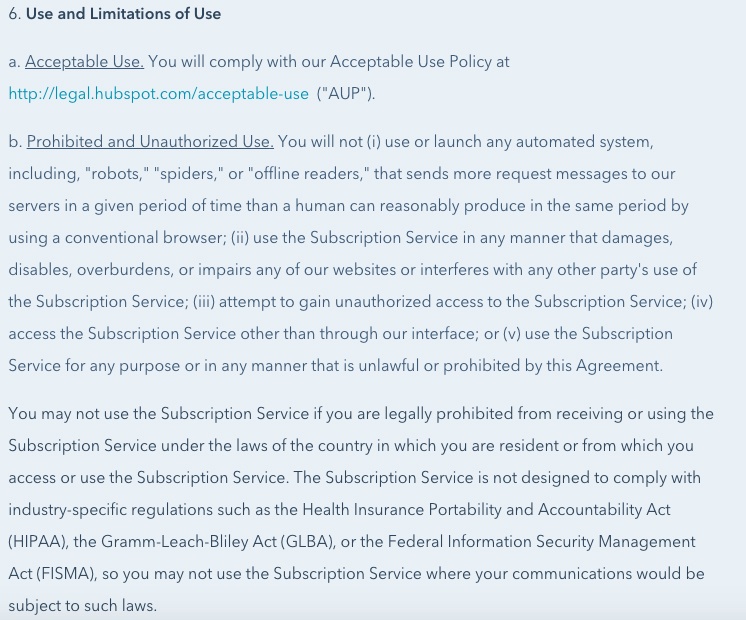
Third, you are able to protect your ownership of your product.
A Terms and Conditions typically includes a section on the company's ownership rights to their software, copyrights, logos, and domain names of their company. This is commonly referred to as an Intellectual Property Clause.
Maintaining your ownership of these rights is extremely important for companies and especially SaaS apps. You are allowing customers to use your software and in many cases use your logo. In a Terms and Conditions, you clearly state you retain those rights and misuse of them violates your contractual agreement.
Here is Zendesk's Intellectual Property Clause spelling out its ownership and what constitutes a violation of the company's rights:
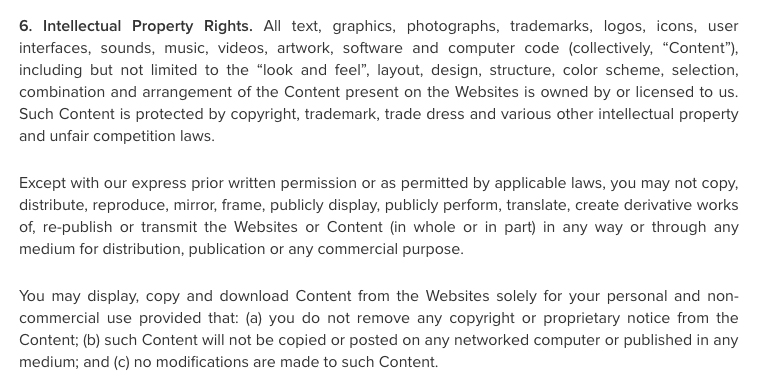
Fourth, Terms and Conditions agreements act as risk management for your company in some key ways.
When writing your Terms and Conditions, the main thing to remember is what potential risks could your company face and how to prevent them. A Terms and Conditions is like preparing for a massive storm. You don't know exactly what could happen, but you must prepare for the worst.
You can include liabilities against misuse of your services, potential profit losses, or indirect damages faced by your users like the workshare app Slack mentions in its Terms of Service:
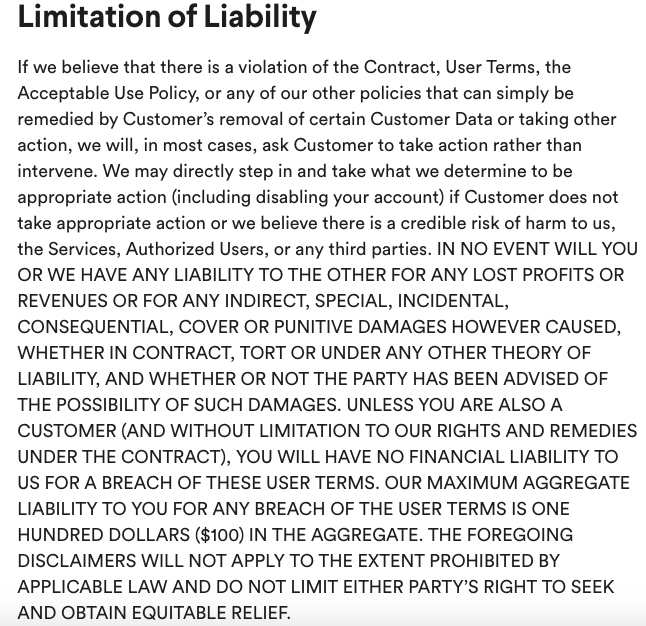
As you can see from some of these examples, a T&C is very important for maintaining your rights, limiting your liability, keeping control over how your SaaS is used and keeping your users informed about all of the above.
What Clauses to Include in Your Terms and Conditions

Not every Terms and Conditions is written the same or includes the same clauses. You should draft your T&C specifically for your company and services. Sticking only to a preprinted or constructed form may not fully protect your company, but using a template could be a good place to start to build off of.
There are some key clauses that your Terms and Conditions should include:
- Statement of creation of legally binding agreement
- Eligibility of using your services
- Licensing information and limitation of uses
- Termination of usage by either the company or by user
- Intellectual Property
- User-generated content
- Payment of services and usage
- Limitation of Liability
- Governing law of terms
- Modification or updates to terms
- Contact information of your company or app
Let's take a look at these in more detail.
Legally Binding Statement
While not necessarily a clause, including a note stating that agreement to your terms constitutes a "legally binding contract" is of utmost importance.
This statement is generally included right at the beginning of the terms and bolded to draw the reader's attention.
Slack's statement notifies its users by bolding their notification and using plain and informal language to not confuse the reader.
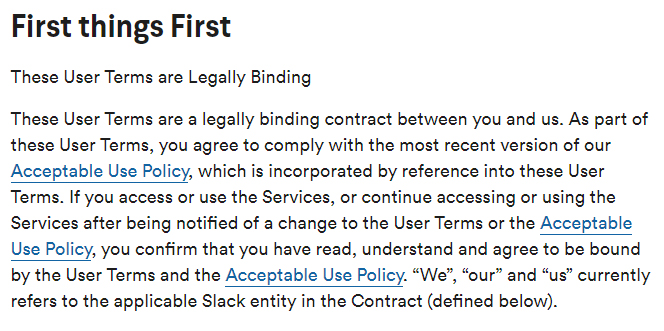
Why is this statement important? Not everyone is an attorney, a business person, or even fully reads every notification pop-up. Having your statement at the beginning makes them immediately aware that they are entering a legal contract and they could face consequences for violating the rules.
DocuSign includes a statement entirely in bold explaining what acceptance of this agreement means and places it at the beginning of its T&C:
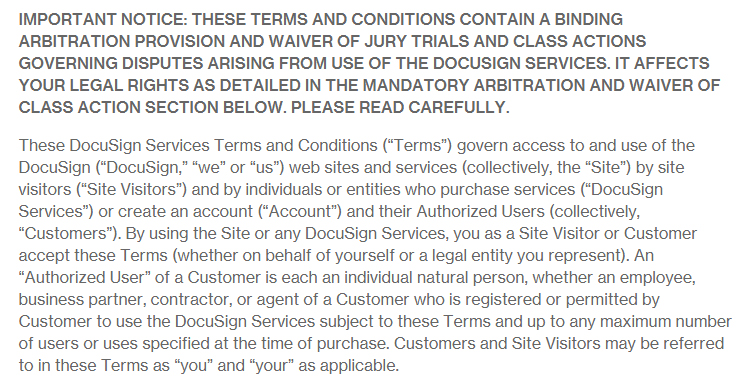
Eligibility of Usage of Services
This clause isn't always included in every SaaS Terms and Conditions. However, you should consider including one. This is because users of apps and the internet are not always adults and the country your company is based in may have restrictions on the types of users you can have.
Most eligibility clauses are also at the beginning of the terms and generally include many of these restrictions:
- Of legal age wherever you live
- Not live in a country embargoed by the US (or another country)
- Agree to the terms
- Complete registration (if applicable)
- Provide updated billing information (if applicable)
Mailchimp includes most of these restrictions as their software is generally used by bloggers and internet companies in a wide variety of countries
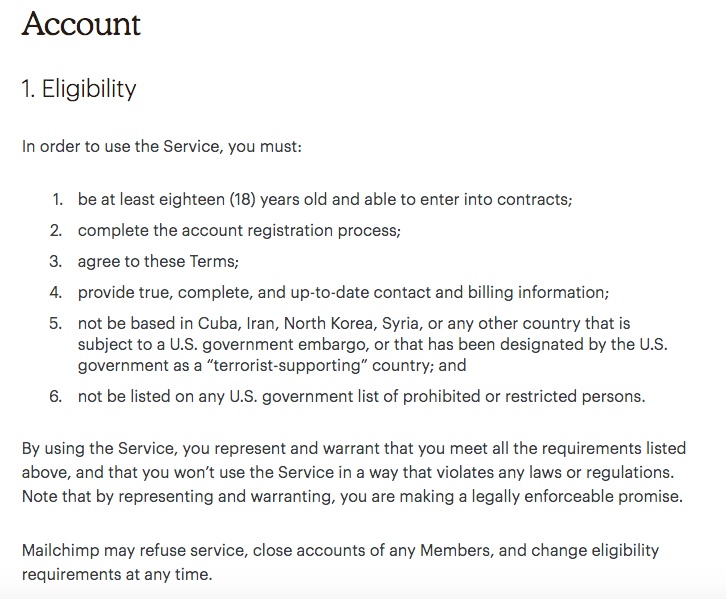
Including this clause adds another level of control and protection for your company by dictating who can use your products.
Another more detailed example with additional restrictions can be seen from Shopify:
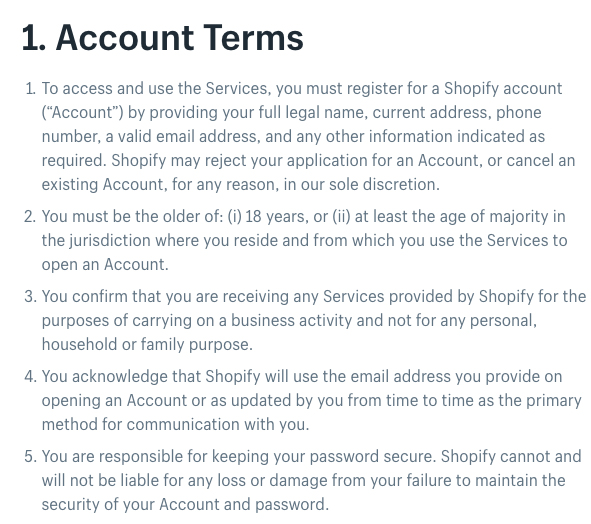
Licensing Information and Limitation
Probably the most important clause in your Terms and Conditions in the one addressing prohibited uses of your services. This clause should include clear and explicit restrictions on what your customer can do and how your customer can interact with your products and software.
This clause is essential to making sure you control the usage of your products, but can also protect you from possible future risks. Some of these restrictions may be common among other SaaS companies, but you should make sure to tailor your terms to your specific company and products. They also include how much license and rights the user has to the software or services.
Twilio limits its users to very few applications and uses of the software:
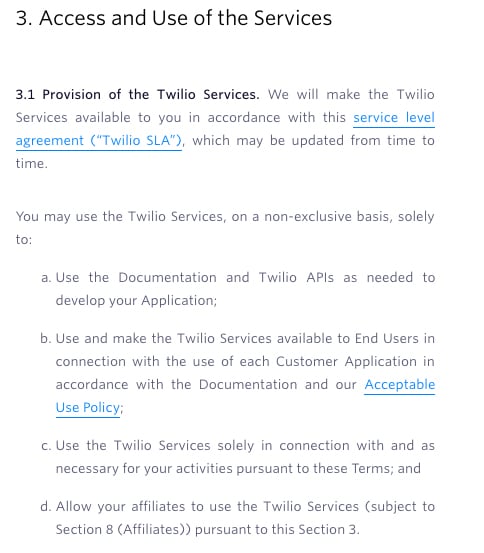
If you have more restrictions than can fit in a simple paragraph, like GitHub, including links to a separate page for acceptable use and policies should be included. This helps keep your main T&C organized and digestible while making sure your users can find detailed, thorough information if they want to:
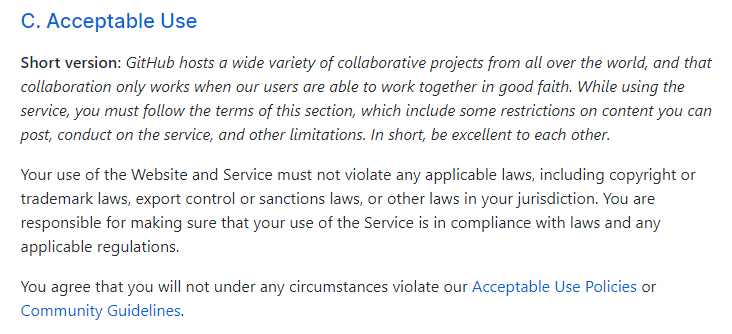
Specific licenses and whether you can duplicate, copy, or sell the services can also included in this section as Amazon Web Services does in its terms:
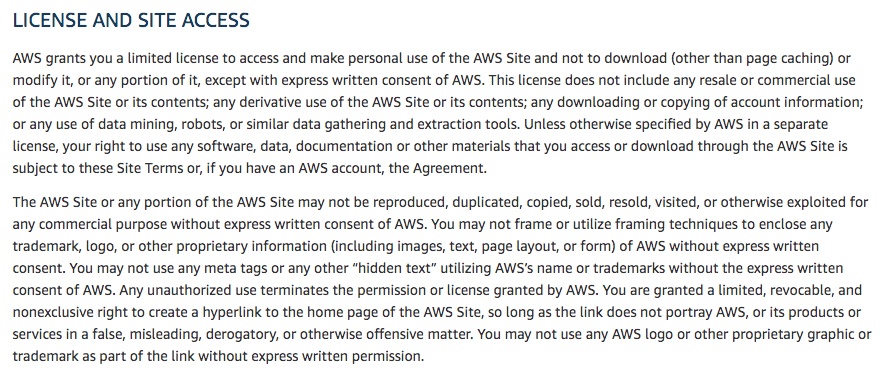
Termination of Usage
The termination of use of services varies depending on the company. This section usually includes how your company or your users may terminate the use, for cause and sometimes without cause.
The clause acts as a notification to your user that you may stop usage at any point and that you are not liable for any issues arising out of this cancellation.
Oracle's Termination of Use clause is short, but to the point:

The termination section can also be extensive depending on all of the services you provide or if there are multiple users who have access to the software.
Adobe includes its general termination terms for single users:

It also includes information about termination by Group Administrators:

Intellectual Property
Protecting your copyrights, patents, trademarks, and more is very important for companies, especially internet and mobile apps. For SaaS companies, it is even more important.
Including a clause about the retention of those rights protects your company's business and financial future. Since the nature of SaaS companies is providing downloadable software to multiple users who use the services in multiple ways, and can even display your trademark, it is pertinent to lay out your rules.
ServiceNow breaks down not only the intellectual property rights for the website, but also for the content and services provided:
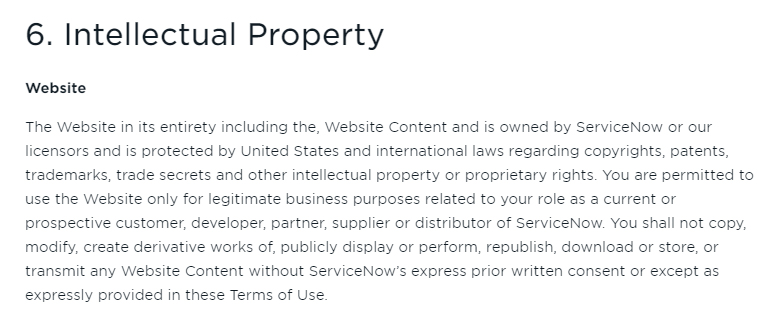
You can also include a link to a larger policy protecting your intellectual rights and the ramifications of any violation or query into any infringement as Square does:

User-Generated Content
A user-generated content clause is not always applicable to every SaaS company. User-generated content is when your company allows users to add their own personally created content to your webpage, blog posts, comments, or social media. Allowing this content can be a boost to your company, but can also come with pitfalls.
Allowing offensive content, using pictures unlawfully, etc., can lead to potential risk management issues.
You should create a clause that outlines the restrictions and type of content you allow, including:
- Ownership of content rules
- Guidelines
- Copyright infringement
- Lawfulness of content
- Not allowing defamatory or offensive content
- Content that is damaged or has viruses
Sophos allows its users to post to the company blog. However, it imposes strict restrictions on the type of content and how it may be posted:
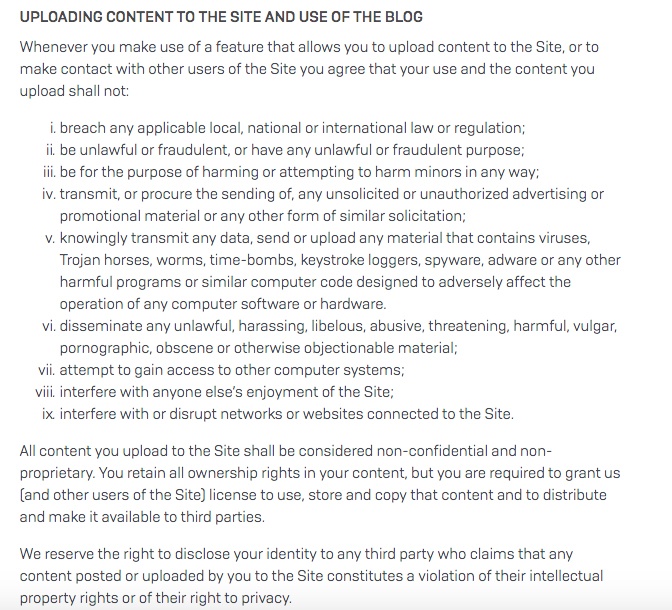
Another example of an extensive user-generated content is from one of the largest SaaS companies, Google:
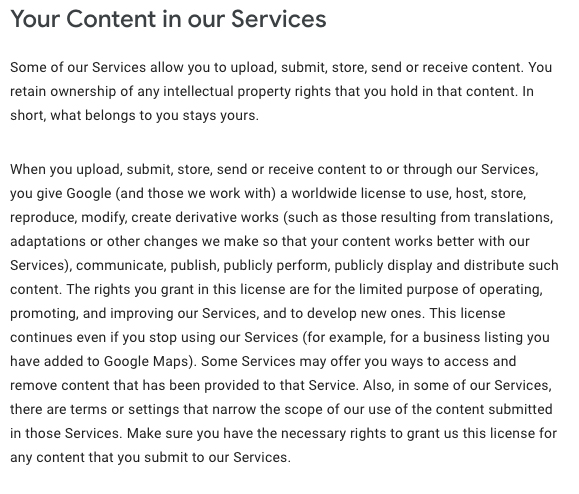
Payment of Services and Usage
Some SaaS companies do not require payment of their services or software. However, if you require your users to subscribe or pay for the download or additional services, you must include a payment service and fees section.
Included in this section are terms for how users pay for the services, updating billing, and warranting that the information you provided is accurate.
LogMeIn's Payment and Fees Section also includes actions they may take if you fail to pay or the information is inaccurate.
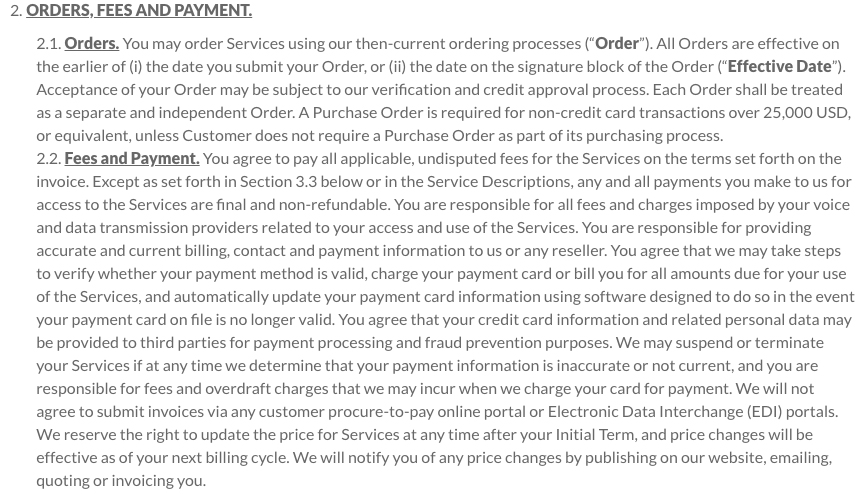
There are some services provided that may be subject to taxes. Survey generator company SurveyMonkey has a payment clause that includes a section about taxes that may need to be paid by the user and releasing its responsibility for that payment:
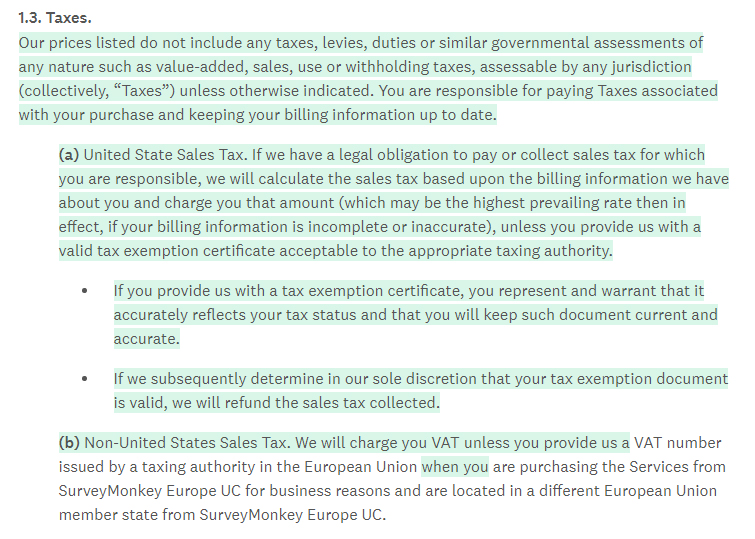
Limitation of Liability
A Terms and Conditions is meant to help you prevent future risk management issues. One of the sections that is directly applicable to this is the limitation of liability clause.
In the clause, you can state your limitation to issues with third-parties, issues arising from using their site, any lost financials or property and other potential issues.
Here's how Workday does this in its Liability clause:

This clause is often fully bolded or capitalized to clearly notify the user of these limits of liability. Zoom capitalizes the entire section in its terms:

Governing Law
Legal issues inevitably will occur. However, not every state or jurisdiction has the same laws. Including a governing law clause for your website and services allows you to dictate where any potential future legal actions will be filed.
This may seem like an unnecessary clause, but the jurisdiction can have major implications if their laws are favorable or unfavorable to your issue.
KnowBe4 declares Florida as the governing law for any future lawsuits or disputes and even includes the specific state courts where you would have to file:
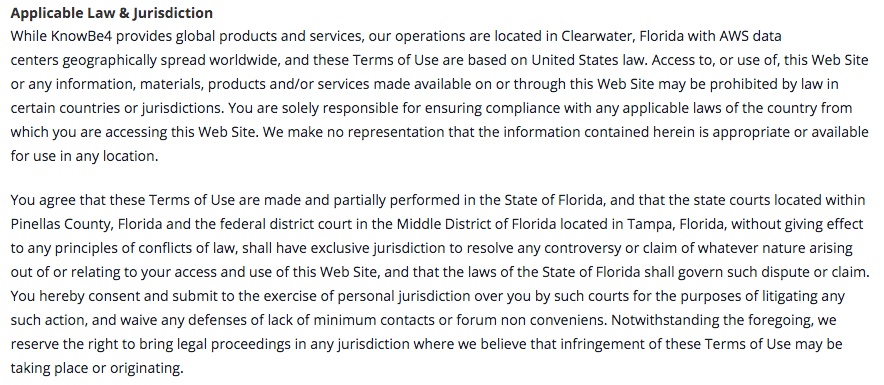
Modification or Updates to the Terms
Companies are constantly modifying their terms as technology advances or new services are provided.
A modification to terms clause puts your users on notice of when terms may change and that they may change. Buffer even goes as far as to include date ranges of when changes will come into effect:

Dropbox lays out its right to modify the terms and let users know they will be notified by email to any of these changes, allowing the user to accept or reject the new terms:

Contact Information and How to Contact
Your users need to be able to contact your company if any issue arises. It is helpful to include a section containing your company's contact information such as address, phone number, and/or email address.
This section is usually included at the bottom of the terms as it is a common place consumers would look. Pardot includes full contact information if any of its users need help or have concerns:

Note how it includes a mailing address and email address to allow for multiple methods of contact. This helps make the company accessible to more users.
How to Display and Get Agreement to Your Terms and Conditions

Links to your Terms and Conditions should be clear and easily accessible.
There are multiple locations of where you can include your link, depending on whether your user is accessing your website or your mobile app. You can include them in:
- The footer of your website
- In the actual desktop or web app in the Settings or other relevant menu
- Legal/About menu in mobile apps
Zendesk includes a link in the most common place, in the footer of its website:

In Google applications on your computer you can access the T&C in the About Google or About Chrome section under Settings when you have the application open:

In Adobe's Photoshop or Lightroom apps you can find links to the Terms and Conditions in the About PS or About Lightroom section within the "Legal" section:
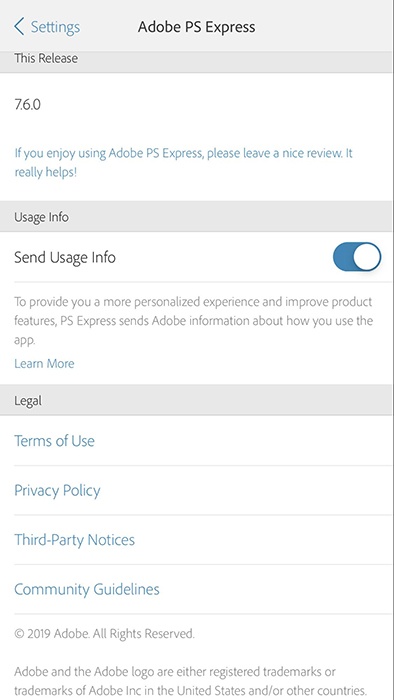
Getting Agreement
A Terms and Conditions Agreement is legally binding, once there is agreement. If you do not receive agreement by the user, than the Terms and Conditions isn't enforceable and in any future legal issues that arise the Terms and Conditions won't be applicable.
You should include a clearly labeled "Accept" button for your Terms and Conditions or use a checkbox for the user to actively check for acceptance of the terms. These acceptance options are typically included in pop-ups, emails, or on sign-up forms.
An example of an "Accept" button or "Sign Up" button can be seen on Adobe's sign-up form for new accounts:
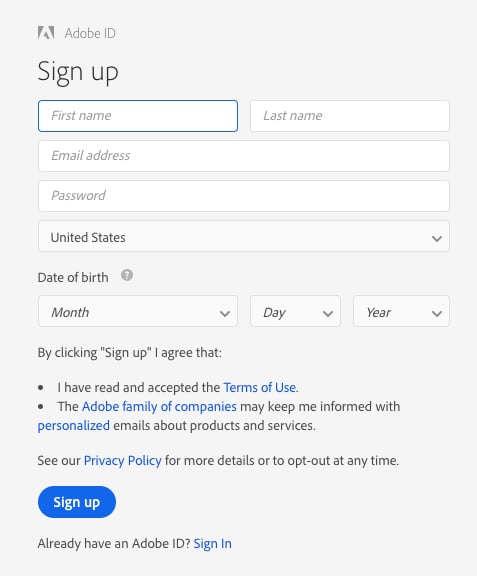
MuleSoft is an example of including an unchecked box for your new users to create an account:
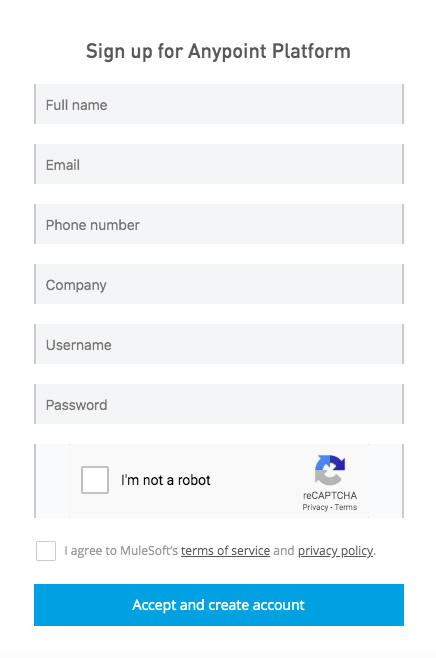
Note: As you might have noticed, many of these agreements are displayed before the user has access to the software or service. A user must accept your terms before they even use your products. If they don't, there could potentially be issues later.
Summary
In summary, while not legally required, including a Terms and Conditions Agreement for your SaaS's website is highly recommended and exceptionally beneficial.
A Terms and Conditions allows your company to dictate your rules for the usage of your software and services, protects your ownership rights in your products, and helps prevent possible risks down the road.
Making sure you cover all of your bases by including important clauses will protect you if an issue arises. Always get users to agree to it, and make sure it's displayed consistently for users to access at any time, both before and after signing up with your SaaS.
Remember, you may not know what is coming, but you need to prepare for everything and protect your company.
